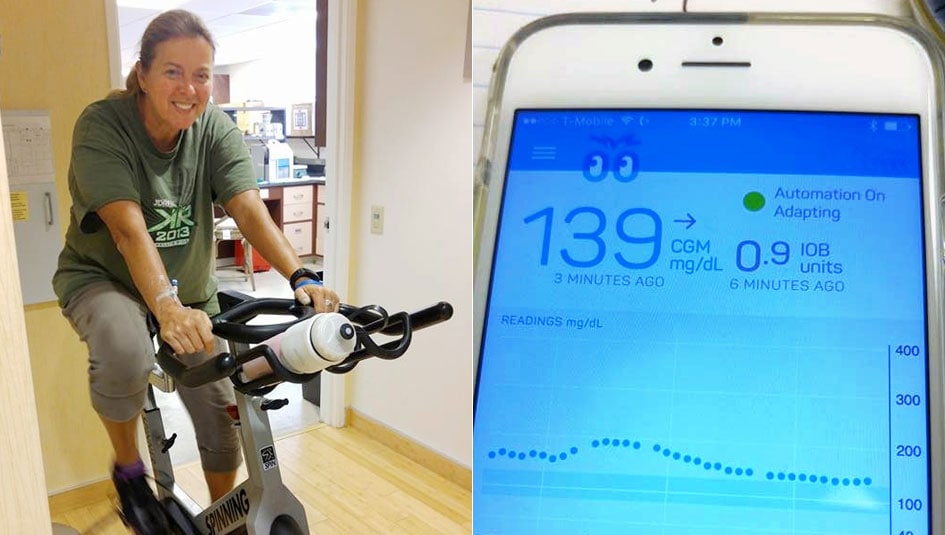I Was Hooked Up to Bigfoot’s Artificial Pancreas

I was diagnosed with Type 1 diabetes in 1974 and heard about the possibility of an artificial pancreas two decades later. Recently, I got to wear one from Bigfoot Biomedical.
I heard the term “artificial pancreas” for the first time in 1995 from Dr. Jay Skyler, the noted diabetes researcher who is now a Professor of Medicine, Pediatrics and Psychology at the University of Miami Miller School of Medicine. Dr. Skyler waxed poetic about a mythical system used to keep blood sugars steady for people with Type 1. It seemed awfully far-fetched, since the only way to monitor blood sugar levels was intravenously, and we still had to bolus 30 minutes before meals. Dr. Skyler asserted this device would be a reality in a mere 20 years. Since I didn’t expect to live past 40, I put the artificial pancreas on the shelf, next to that “cure is right around the corner” promise.
Technology surged forward at the turn of the century and, perhaps not coincidentally, I made it past 40. We got speedy insulin, continuous glucose monitors (CGMs), and better pumps. We started hearing rumors in the diabetes underground about insulin pumps that were jury-rigged to be transformed into crude artificial pancreas systems. This became the Nightscout project.
For my part, after 21 years with Medtronic, I jumped ship for the Asante Snap, which had many design features I liked better and held out the promise of potential future integration with a Dexcom CGM. Unfortunately, just six months later, Asante shut down. Devastated, I fielded calls from Animas, Medtronic, and Tandem representatives, all salivating for my business. Instead, I madly ordered supplies. I was going rogue.
Two weeks after Asante shut down, a startup called Bigfoot Biomedical snapped up the Asante technology. I’d read the Wired article about Bigfoot founder Bryan Mazlish, who created a homemade artificial pancreas for his son, and I already knew and was impressed with CEO Jeffrey Brewer from his days leading JDRF. I began to track Bigfoot.
I did an artificial pancreas trial in 2015 at the Sansum Diabetes Center in Santa Barbara, and in June, they emailed to see if I was still interested in future trials. “We can’t say what it is just yet, as approval is still pending,” they said.
When I learned that I had the honor to take part in the first clinical trial for Bigfoot Biomedical’s automated insulin delivery system, I was ecstatic.
The Bigfoot system, built upon Asante technology, has three components – the pump body, the Dexcom G5 CGM, and a controller. The body is a single-use, disposable piece that contains a battery and a 3-milliliter cartridge of Humalog. The Dexcom G5 sends glucose readings to the controller, which is the brains of the operation. The controller runs an algorithm that predicts glucose excursions and turns insulin on and off in response. While the controller does the math, the user still enters carbs and can always override it.
When I checked in for the study, researchers used data from my pump, meter, and CGM to help configure the controller. It took a while, and three nurses, to get an IV started, but once I was tapped, a new pump site was added, and the Asante/Bigfoot system was quickly set up. The loop was closed!
Day 1
The first curve came on the first night. Bigfoot had shut off my basal shortly after dinner, but I was dropping. After some juice, I watched as the basal insulin delivery came back on, and I woke up the next day to a perfect breakfast blood sugar.
Day 2
For breakfast that day, an extra 30 percent was added to the bolus. Within minutes, the basal had turned off, and I never dropped too low. Lunch was relatively high in fat, which can be a headache, but Bigfoot turned off the basal until it predicted a rise two hours later. When it came time for dinner, we just ate with no bolus. Bigfoot took over, and my numbers were so good, I even got a bedtime snack. There was no midnight crash, either, as the system tweaked my basal rate.
Day 3
For Sunday breakfast, we took Bigfoot’s suggested insulin, and three hours later, I was on a stationary bike. No advance basal reduction, no pockets full of energy gels, I just jumped on and started pedaling. Basal insulin delivery turned off immediately.
After 15 minutes, they drew blood. During the second 15 minute session, Bigfoot predicted a low, so I drank juice, but continued to pedal. They drew more blood, and my basal stayed off. After another 15 minutes, I ended just under 80 mg/dL, but within minutes, the arrow was pointed up. The system turned back on, however, so instead of my usual rebound, which would have led to high blood sugar levels, I was at a perfectly normal level 30 minutes later in time for lunch.
At 3 pm, I reluctantly removed the system [read: they peeled my fingers away]. The second set of patients was starting the day we left, and additional clinical trials are gearing up in Denver and Stanford.
I have one month of Snap pump supplies left, but I am hopeful for the near future. Bigfoot plans to conduct their pivotal trial next year, aiming to submit to the FDA for approval by the end of 2017. I will remain vigilant, keep my eyes peeled, and my hope on high alert. Bigfoot is real. I believe in Bigfoot!